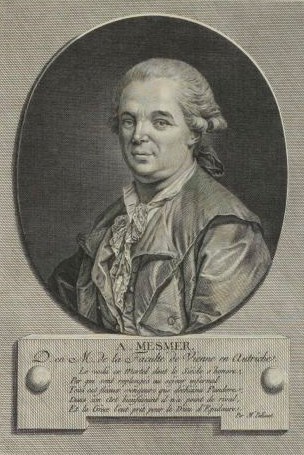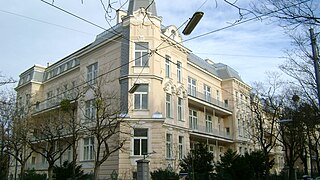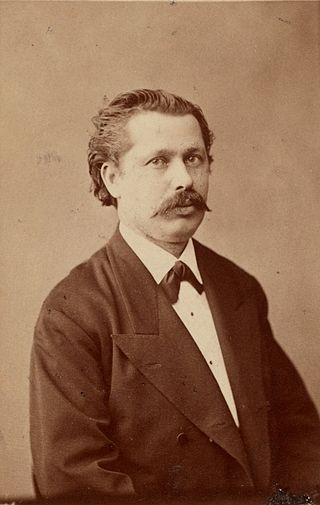
Franz Anton Mesmer was a German physician with an interest in astronomy. He theorized the existence of a process of natural energy transference occurring between all animate and inanimate objects; this he called "animal magnetism", later referred to as mesmerism. Mesmer's theory attracted a wide following between about 1780 and 1850, and continued to have some influence until the end of the 19th century. In 1843, the Scottish doctor James Braid proposed the term "hypnotism" for a technique derived from animal magnetism; today the word "mesmerism" generally functions as a synonym of "hypnosis". Mesmer also supported the arts, specifically music; he was on friendly terms with Haydn and Mozart.

Ignaz Philipp Semmelweis was a Hungarian physician and scientist of German descent, who was an early pioneer of antiseptic procedures, and was described as the "saviour of mothers". Postpartum infection, also known as puerperal fever or childbed fever, consists of any bacterial infection of the reproductive tract following birth, and in the 19th century was common and often fatal. Semmelweis discovered that the incidence of infection could be drastically reduced by requiring healthcare workers in obstetrical clinics to disinfect their hands. In 1847, he proposed hand washing with chlorinated lime solutions at Vienna General Hospital's First Obstetrical Clinic, where doctors' wards had three times the mortality of midwives' wards. The maternal mortality rate dropped from 18% to less than 2%, and he published a book of his findings, Etiology, Concept and Prophylaxis of Childbed Fever, in 1861.

Christian Friedrich Samuel Hahnemann was a German physician, best known for creating the pseudoscientific system of alternative medicine called homeopathy.

Abū al-Qāsim Khalaf ibn al-'Abbās al-Zahrāwī al-Ansari, popularly known as al-Zahrawi (الزهراوي), Latinised as Albucasis or Abulcasis, was a physician, surgeon and chemist from al-Andalus. He is considered one of the greatest surgeons of the Middle Ages.

Baron Carl von Rokitansky was an Austrian physician, pathologist, humanist philosopher and liberal politician, founder of the Viennese School of Medicine of the 19th century. He was the founder of science-based diagnostics.

Ferdinand Karl Franz Schwarzmann, Ritter von Hebra was an Austrian Empire physician and dermatologist known as the founder of the New Vienna School of Dermatology, an important group of physicians who established the foundations of modern dermatology.

Sir Thomas Clifford Allbutt was an English physician best known for his role as president of the British Medical Association 1920, for inventing the clinical thermometer, and for supporting Sir William Osler in founding the History of Medicine Society.
The Medical University of Vienna is a public university located in Vienna, Austria. It is the direct successor to the faculty of medicine at the University of Vienna, founded in 1365 by Rudolf IV, Duke of Austria. As one of the oldest medical schools in the world, it is the oldest in the German-speaking countries, and was the second medical faculty in the Holy Roman Empire, after the Charles University of Prague.

Joseph Škoda was an Austrian physician, medical professor and dermatologist. Together with Carl Freiherr von Rokitansky, he was the founder of the Modern Medical School of Vienna.

Medical jurisprudence or legal medicine is the branch of science and medicine involving the study and application of scientific and medical knowledge to legal problems, such as inquests, and in the field of law. As modern medicine is a legal creation, regulated by the state, and medicolegal cases involving death, rape, paternity, etc. require a medical practitioner to produce evidence and appear as an expert witness, these two fields have traditionally been interdependent.
A medical thermometer or clinical thermometer is a device used for measuring the body temperature of a human or other animal. The tip of the thermometer is inserted into the mouth under the tongue, under the armpit, into the rectum via the anus, into the ear, or on the forehead.

Rudolf R. Urbantschitsch, later Rudolf von Urban, was an Austrian psychiatrist and psychologist who researched human sexuality.

Leopold Schrötter Ritter von Kristelli, was an Austrian internist and laryngologist born in Graz. He was the son of chemist Anton Schrötter von Kristelli, and father to physician Hermann Schroetter-Kristelli (1870–1928).

Johann Schnitzler was an Austrian Jewish laryngologist and professor. He was the father of Arthur Schnitzler.

Maximilian Stoll was an Austrian physician who was a native of Erzingen, Baden-Württemberg.

Anton von Störck was an Austrian physician who was a native of Saulgau in Upper Swabia.

Eduard von Hofmann was an Austrian physician who was a native of Prague. He was a pioneer of modern forensic pathology.

Victor Eisenmenger was an Austrian medical doctor. The son of portrait painter and professor August Eisenmenger, he attended the University of Vienna and became the personal physician of Archduke Franz Ferdinand. Eisenmenger's syndrome – a phenomenon in which longstanding heart defects affect the blood flow to a person's lungs – is named in his honor.

Leopold (Löb) Oser was an Austrian physician. He was a full professor at the University of Vienna, and – alongside Carl Anton Ewald from Berlin – was the first doctor to use a soft stomach tube instead of a rigid tube for gastroscopy.
Richard Huck-Saunders was an English physician.

















